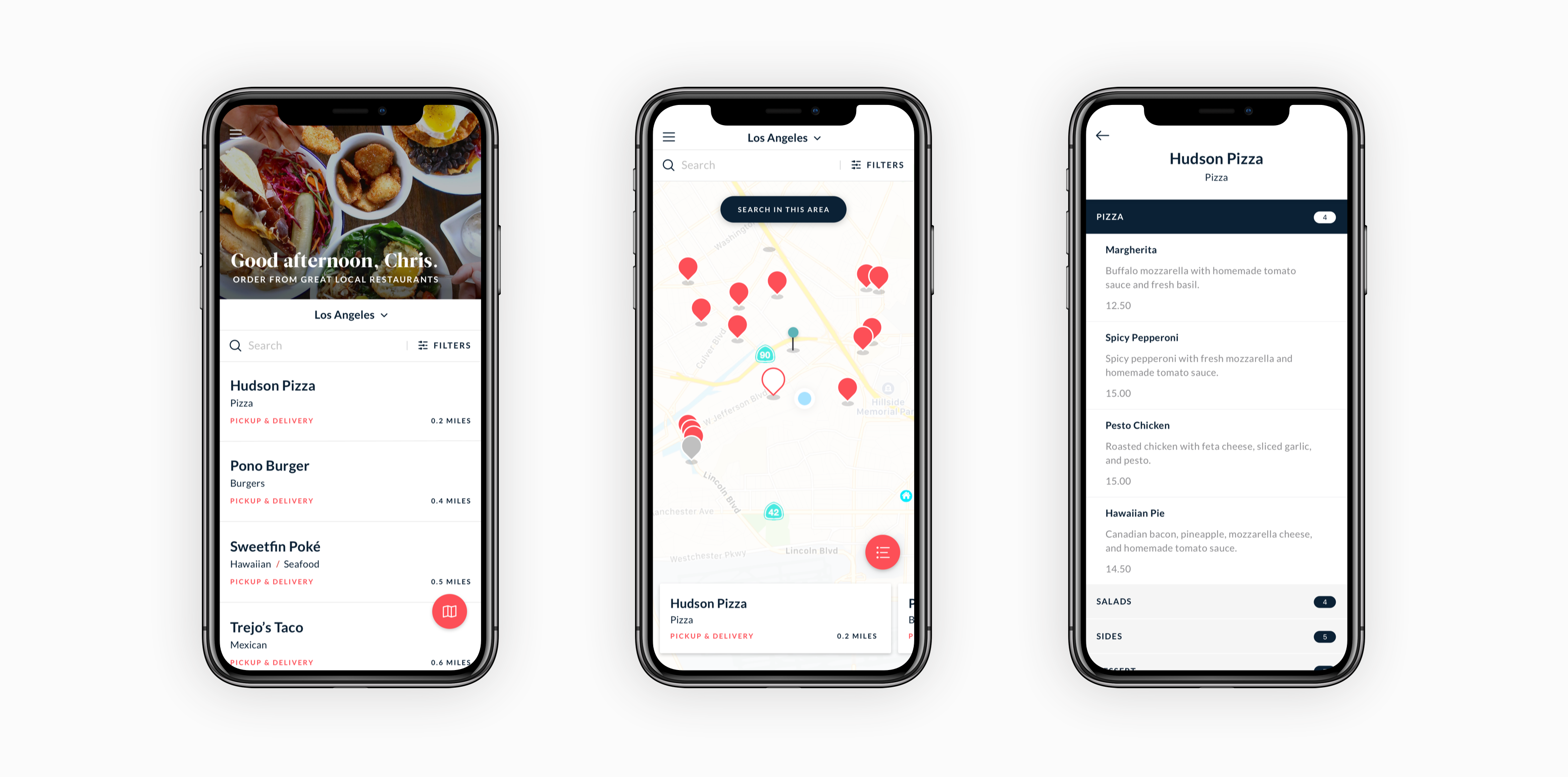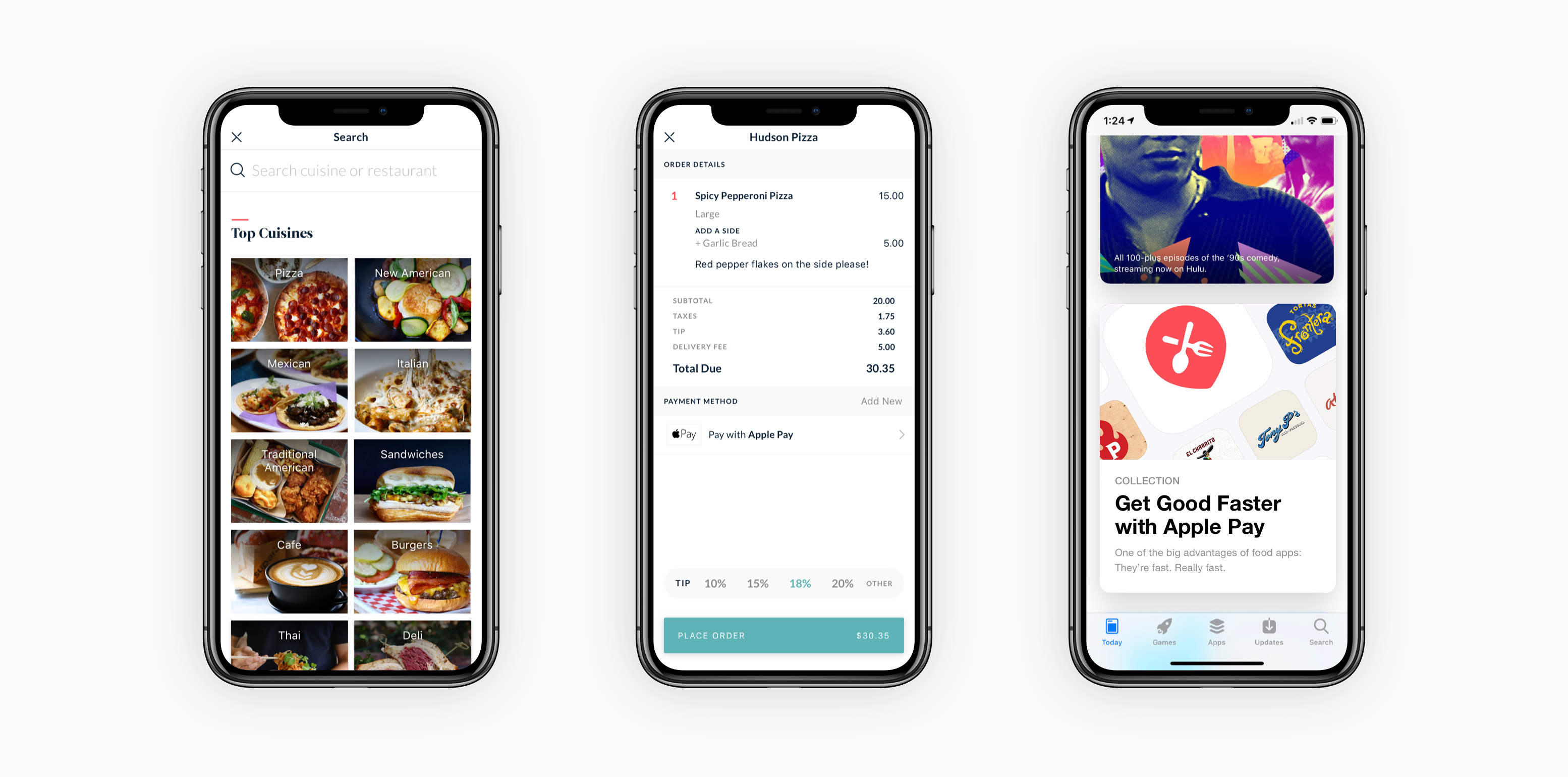Helping restaurants grow their businesses–
Helping restaurants grow their businesses–
Helping restaurants grow their businesses–
Helping restaurants grow their businesses–
Helping restaurants grow their businesses–
CHOWNOW • LOS ANGELES
CHOWNOW • LOS ANGELES
CHOWNOW • LOS ANGELES
CHOWNOW • LOS ANGELES
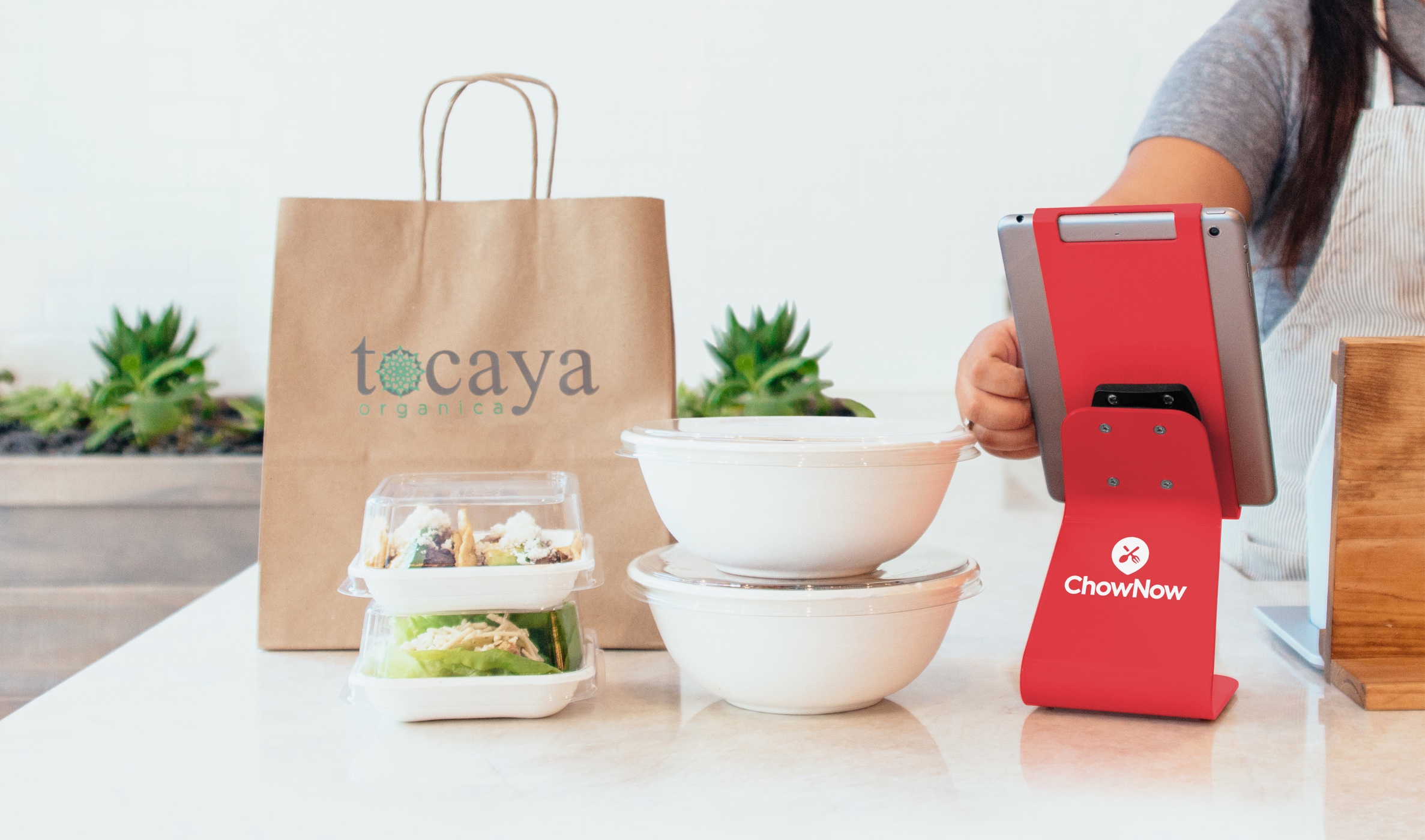
Photo: Erin Doll
ChowNow is an online food ordering platform with a mission to help local restaurants grow their businesses by strengthening relationships with their customers. Unlike other companies in the food ordering industry, ChowNow is not only a centralized, consumer-facing marketplace. Rather, it allows restaurants to use the ChowNow technology to take orders directly through the restaurant’s website, apps, and social channels.
ChowNow is an online food ordering platform with a mission to help local restaurants grow their businesses by strengthening relationships with their customers. Unlike other companies in the food ordering industry, ChowNow is not only a centralized, consumer-facing marketplace. Rather, it allows restaurants to use the ChowNow technology to take orders directly through the restaurant’s website, apps, and social channels.
ChowNow is an online food ordering platform with a mission to help local restaurants grow their businesses by strengthening relationships with their customers. Unlike other companies in the food ordering industry, ChowNow is not only a centralized, consumer-facing marketplace. Rather, it allows restaurants to use the ChowNow technology to take orders directly through the restaurant’s website, apps, and social channels.
ChowNow is an online food ordering platform with a mission to help local restaurants grow their businesses by strengthening relationships with their customers. Unlike other companies in the food ordering industry, ChowNow is not only a centralized, consumer-facing marketplace. Rather, it allows restaurants to use the ChowNow technology to take orders directly through the restaurant’s website, apps, and social channels.
ChowNow is an online food ordering platform with a mission to help local restaurants grow their businesses by strengthening relationships with their customers. Unlike other companies in the food ordering industry, ChowNow is not only a centralized, consumer-facing marketplace. Rather, it allows restaurants to use the ChowNow technology to take orders directly through the restaurant’s website, apps, and social channels.
Role
Director of Design
August 2016 - October 2018
As Director of Design, my role was to build an in-house design team to support ChowNow’s roadmap objectives, inherit the existing brand and own its evolution, and provide design direction to guide company milestones.
Impact
During my time there, we went from being a white label B2B product helping restaurants compete in online ordering to launching a consumer-facing marketplace while simultaneously repositioning the brand, raised $20mm in a series B round, outgrew our headquarters, and tripled the design team.
- Scaled a team of 3 to 9 product, growth, and production designers responsible for communications and branding, the functionality of ChowNow’s consumer marketplace product, the restaurant white label products, and marketing materials.
- Designed and launched ChowNow’s premier consumer facing marketplace platform aimed at being the most restaurant friendly way for customers to order food.
- Implemented a plug-and-play design system for white label apps, resulting in over 10,000 iOS & Android apps.
- Streamlined workflows for designers and increased average number of marketing collateral designed per month from 700 to 1,100 (57% MoM).
- Instilled a strong design culture, uncovered creative confidence, managed ongoing career development and feedback, and offered hands-on coaching to direct and indirect reports.
Role
Director of Design
August 2016 - October 2018
As Director of Design, my role was to build an in-house design team to support ChowNow’s roadmap objectives, inherit the existing brand and own its evolution, and provide design direction to guide company milestones.
Impact
During my time there, we went from being a white label B2B product helping restaurants compete in online ordering to launching a consumer-facing marketplace while simultaneously repositioning the brand, raised $20mm in a series B round, outgrew our headquarters, and tripled the design team.
- Scaled a team of 3 to 9 product, growth, and production designers responsible for communications and branding, the functionality of ChowNow’s consumer marketplace product, the restaurant white label products, and marketing materials.
- Designed and launched ChowNow’s premier consumer facing marketplace platform aimed at being the most restaurant friendly way for customers to order food.
- Implemented a plug-and-play design system for white label apps, resulting in over 10,000 iOS & Android apps.
- Streamlined workflows for designers and increased average number of marketing collateral designed per month from 700 to 1,100 (57% MoM).
- Instilled a strong design culture, uncovered creative confidence, managed ongoing career development and feedback, and offered hands-on coaching to direct and indirect reports.
Role
Director of Design
August 2016 - October 2018
As Director of Design, my role was to build an in-house design team to support ChowNow’s roadmap objectives, inherit the existing brand and own its evolution, and provide design direction to guide company milestones.
Impact
During my time there, we went from being a white label B2B product helping restaurants compete in online ordering to launching a consumer-facing marketplace while simultaneously repositioning the brand, raised $20mm in a series B round, outgrew our headquarters, and tripled the design team.
- Scaled a team of 3 to 9 product, growth, and production designers responsible for communications and branding, the functionality of ChowNow’s consumer marketplace product, the restaurant white label products, and marketing materials.
- Designed and launched ChowNow’s premier consumer facing marketplace platform aimed at being the most restaurant friendly way for customers to order food.
- Implemented a plug-and-play design system for white label apps, resulting in over 10,000 iOS & Android apps.
- Streamlined workflows for designers and increased average number of marketing collateral designed per month from 700 to 1,100 (57% MoM).
- Instilled a strong design culture, uncovered creative confidence, managed ongoing career development and feedback, and offered hands-on coaching to direct and indirect reports.
Role
Director of Design
August 2016 - October 2018
As Director of Design, my role was to build an in-house design team to support ChowNow’s roadmap objectives, inherit the existing brand and own its evolution, and provide design direction to guide company milestones.
Impact
During my time there, we went from being a white label B2B product helping restaurants compete in online ordering to launching a consumer-facing marketplace while simultaneously repositioning the brand, raised $20mm in a series B round, outgrew our headquarters, and tripled the design team.
- Scaled a team of 3 to 9 product, growth, and production designers responsible for communications and branding, the functionality of ChowNow’s consumer marketplace product, the restaurant white label products, and marketing materials.
- Designed and launched ChowNow’s premier consumer facing marketplace platform aimed at being the most restaurant friendly way for customers to order food.
- Implemented a plug-and-play design system for white label apps, resulting in over 10,000 iOS & Android apps.
- Streamlined workflows for designers and increased average number of marketing collateral designed per month from 700 to 1,100 (57% MoM).
- Instilled a strong design culture, uncovered creative confidence, managed ongoing career development and feedback, and offered hands-on coaching to direct and indirect reports.
Role
Director of Design
August 2016 - October 2018
As Director of Design, my role was to build an in-house design team to support ChowNow’s roadmap objectives, inherit the existing brand and own its evolution, and provide design direction to guide company milestones.
Impact
During my time there, we went from being a white label B2B product helping restaurants compete in online ordering to launching a consumer-facing marketplace while simultaneously repositioning the brand, raised $20mm in a series B round, outgrew our headquarters, and tripled the design team.
- Scaled a team of 3 to 9 product, growth, and production designers responsible for communications and branding, the functionality of ChowNow’s consumer marketplace product, the restaurant white label products, and marketing materials.
- Designed and launched ChowNow’s premier consumer facing marketplace platform aimed at being the most restaurant friendly way for customers to order food.
- Implemented a plug-and-play design system for white label apps, resulting in over 10,000 iOS & Android apps.
- Streamlined workflows for designers and increased average number of marketing collateral designed per month from 700 to 1,100 (57% MoM).
- Instilled a strong design culture, uncovered creative confidence, managed ongoing career development and feedback, and offered hands-on coaching to direct and indirect reports.
How ChowNow Works
MakeSpace iOS User Flow
MakeSpace iOS User Flow
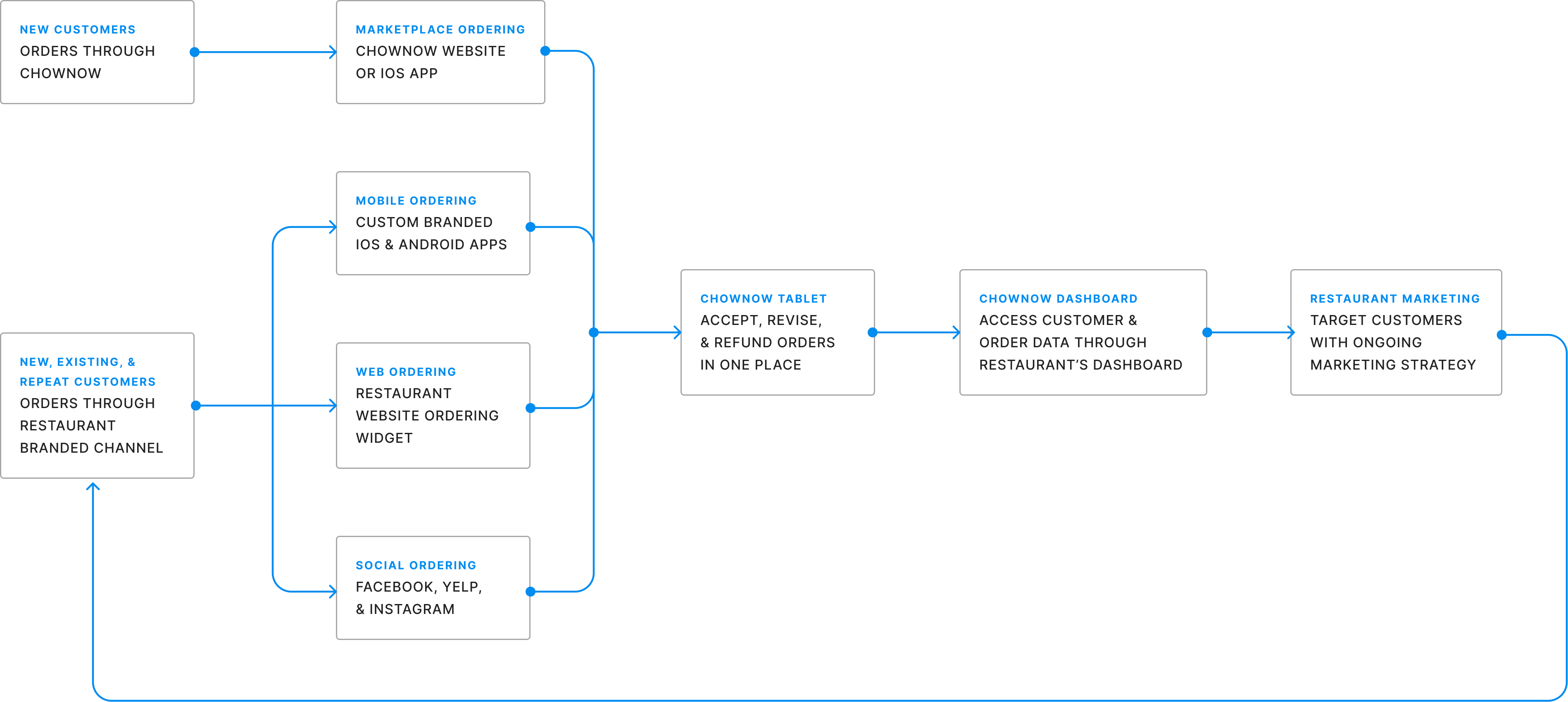
Goals
ChowNow spent years building strong relationships within the restaurant industry. The pricing model has always put the restaurants first. The product allows restaurants to reinforce their own branding through customization. When restaurants sign up with ChowNow, they receive custom branded apps, and the in-house team even designs marketing materials in their branding to help promote the restaurants’ new online ordering system as opposed to marketing ChowNow as a service.
This was already a challenging concept for restaurants who were used to saying, “find us on GrubHub.” Most restaurants do not realize how much that phrase actually hurts them instead of helping them. It directs their loyal customers to a place where these online ordering platforms are taking 20-30% commission on each order, retargeting restaurants’ customers to its competitors, and keeping customer data for themselves. Customer loyalty shifts away from the restaurant to the delivery service in third-party partnerships. ChowNow set out to build a consumer-facing marketplace with the most restaurant-friendly pricing model that would save local restaurants one order at a time.
Goals
ChowNow spent years building strong relationships within the restaurant industry. The pricing model has always put the restaurants first. The product allows restaurants to reinforce their own branding through customization. When restaurants sign up with ChowNow, they receive custom branded apps, and the in-house team even designs marketing materials in their branding to help promote the restaurants’ new online ordering system as opposed to marketing ChowNow as a service.
This was already a challenging concept for restaurants who were used to saying, “find us on GrubHub.” Most restaurants do not realize how much that phrase actually hurts them instead of helping them. It directs their loyal customers to a place where these online ordering platforms are taking 20-30% commission on each order, retargeting restaurants’ customers to its competitors, and keeping customer data for themselves. Customer loyalty shifts away from the restaurant to the delivery service in third-party partnerships. ChowNow set out to build a consumer-facing marketplace with the most restaurant-friendly pricing model that would save local restaurants one order at a time.
Goals
ChowNow spent years building strong relationships within the restaurant industry. The pricing model has always put the restaurants first. The product allows restaurants to reinforce their own branding through customization. When restaurants sign up with ChowNow, they receive custom branded apps, and the in-house team even designs marketing materials in their branding to help promote the restaurants’ new online ordering system as opposed to marketing ChowNow as a service.
This was already a challenging concept for restaurants who were used to saying, “find us on GrubHub.” Most restaurants do not realize how much that phrase actually hurts them instead of helping them. It directs their loyal customers to a place where these online ordering platforms are taking 20-30% commission on each order, retargeting restaurants’ customers to its competitors, and keeping customer data for themselves. Customer loyalty shifts away from the restaurant to the delivery service in third-party partnerships. ChowNow set out to build a consumer-facing marketplace with the most restaurant-friendly pricing model that would save local restaurants one order at a time.
Goals
ChowNow spent years building strong relationships within the restaurant industry. The pricing model has always put the restaurants first. The product allows restaurants to reinforce their own branding through customization. When restaurants sign up with ChowNow, they receive custom branded apps, and the in-house team even designs marketing materials in their branding to help promote the restaurants’ new online ordering system as opposed to marketing ChowNow as a service.
This was already a challenging concept for restaurants who were used to saying, “find us on GrubHub.” Most restaurants do not realize how much that phrase actually hurts them instead of helping them. It directs their loyal customers to a place where these online ordering platforms are taking 20-30% commission on each order, retargeting restaurants’ customers to its competitors, and keeping customer data for themselves. Customer loyalty shifts away from the restaurant to the delivery service in third-party partnerships. ChowNow set out to build a consumer-facing marketplace with the most restaurant-friendly pricing model that would save local restaurants one order at a time.
Goals
ChowNow spent years building strong relationships within the restaurant industry. The pricing model has always put the restaurants first. The product allows restaurants to reinforce their own branding through customization. When restaurants sign up with ChowNow, they receive custom branded apps, and the in-house team even designs marketing materials in their branding to help promote the restaurants’ new online ordering system as opposed to marketing ChowNow as a service.
This was already a challenging concept for restaurants who were used to saying, “find us on GrubHub.” Most restaurants do not realize how much that phrase actually hurts them instead of helping them. It directs their loyal customers to a place where these online ordering platforms are taking 20-30% commission on each order, retargeting restaurants’ customers to its competitors, and keeping customer data for themselves. Customer loyalty shifts away from the restaurant to the delivery service in third-party partnerships. ChowNow set out to build a consumer-facing marketplace with the most restaurant-friendly pricing model that would save local restaurants one order at a time.
ChowNow Rebrand


Challenges
In order for ChowNow to successfully break into a crowded market, we had to give the entire brand a refresh so that it was more relatable to consumers. Since ChowNow had only been a B2B product, the branding was heavily geared towards the restaurant industry–it looked business-like, subdued, and techy. It was lacking both the character and voice that were needed to attract new foodies who order online.
CHALLENGES
In order for ChowNow to successfully break into a crowded market, we had to give the entire brand a refresh so that it was more relatable to consumers. Since ChowNow had only been a B2B product, the branding was heavily geared towards the restaurant industry–it looked business-like, subdued, and techy. It was lacking both the character and voice that were needed to attract new foodies who order online.
CHALLENGES
In order for ChowNow to successfully break into a crowded market, we had to give the entire brand a refresh so that it was more relatable to consumers. Since ChowNow had only been a B2B product, the branding was heavily geared towards the restaurant industry–it looked business-like, subdued, and techy. It was lacking both the character and voice that were needed to attract new foodies who order online.
CHALLENGES
In order for ChowNow to successfully break into a crowded market, we had to give the entire brand a refresh so that it was more relatable to consumers. Since ChowNow had only been a B2B product, the branding was heavily geared towards the restaurant industry–it looked business-like, subdued, and techy. It was lacking both the character and voice that were needed to attract new foodies who order online.
CHALLENGES
In order for ChowNow to successfully break into a crowded market, we had to give the entire brand a refresh so that it was more relatable to consumers. Since ChowNow had only been a B2B product, the branding was heavily geared towards the restaurant industry–it looked business-like, subdued, and techy. It was lacking both the character and voice that were needed to attract new foodies who order online.
We started by thinking about how ChowNow’s marketplace would be different from others. We did not want to hide restaurant info, over crowd menu pages, or cross promote with ads for other restaurants. We realized most of the competitors seemed to be purely transactional. What was missing was the restaurant’s identity, their background stories, and the people behind the food. This became a driving factor for our product mission. We used the concept of storytelling as a guide to refresh the logo, add punch to the color palette, and incorporate editorial typography and layouts that would lend themselves well to telling restaurant stories.
We started by thinking about how ChowNow’s marketplace would be different from others. We did not want to hide restaurant info, over crowd menu pages, or cross promote with ads for other restaurants. We realized most of the competitors seemed to be purely transactional. What was missing was the restaurant’s identity, their background stories, and the people behind the food. This became a driving factor for our product mission. We used the concept of storytelling as a guide to refresh the logo, add punch to the color palette, and incorporate editorial typography and layouts that would lend themselves well to telling restaurant stories.
We started by thinking about how ChowNow’s marketplace would be different from others. We did not want to hide restaurant info, over crowd menu pages, or cross promote with ads for other restaurants. We realized most of the competitors seemed to be purely transactional. What was missing was the restaurant’s identity, their background stories, and the people behind the food. This became a driving factor for our product mission. We used the concept of storytelling as a guide to refresh the logo, add punch to the color palette, and incorporate editorial typography and layouts that would lend themselves well to telling restaurant stories.
We started by thinking about how ChowNow’s marketplace would be different from others. We did not want to hide restaurant info, over crowd menu pages, or cross promote with ads for other restaurants. We realized most of the competitors seemed to be purely transactional. What was missing was the restaurant’s identity, their background stories, and the people behind the food. This became a driving factor for our product mission. We used the concept of storytelling as a guide to refresh the logo, add punch to the color palette, and incorporate editorial typography and layouts that would lend themselves well to telling restaurant stories.
We started by thinking about how ChowNow’s marketplace would be different from others. We did not want to hide restaurant info, over crowd menu pages, or cross promote with ads for other restaurants. We realized most of the competitors seemed to be purely transactional. What was missing was the restaurant’s identity, their background stories, and the people behind the food. This became a driving factor for our product mission. We used the concept of storytelling as a guide to refresh the logo, add punch to the color palette, and incorporate editorial typography and layouts that would lend themselves well to telling restaurant stories.
Successes
Storytelling is now an essential principle for our brand voice and products. We use this empathetic approach to guide the design of our new marketplace, redesigns of over a hundred sales materials, dozens of email templates, and essentially every form of communication for ChowNow. Along with adding restaurant captions to food photography, we put guidelines in place that would require the majority of images to have human touches including restaurant owners, chefs, and kitchen staff. We decorated our headquarters with these images and even incorporated them into our product mission.
SUCCESSES
Storytelling is now an essential principle for our brand voice and products. We use this empathetic approach to guide the design of our new marketplace, redesigns of over a hundred sales materials, dozens of email templates, and essentially every form of communication for ChowNow. Along with adding restaurant captions to food photography, we put guidelines in place that would require the majority of images to have human touches including restaurant owners, chefs, and kitchen staff. We decorated our headquarters with these images and even incorporated them into our product mission.
SUCCESSES
Storytelling is now an essential principle for our brand voice and products. We use this empathetic approach to guide the design of our new marketplace, redesigns of over a hundred sales materials, dozens of email templates, and essentially every form of communication for ChowNow. Along with adding restaurant captions to food photography, we put guidelines in place that would require the majority of images to have human touches including restaurant owners, chefs, and kitchen staff. We decorated our headquarters with these images and even incorporated them into our product mission.
SUCCESSES
Storytelling is now an essential principle for our brand voice and products. We use this empathetic approach to guide the design of our new marketplace, redesigns of over a hundred sales materials, dozens of email templates, and essentially every form of communication for ChowNow. Along with adding restaurant captions to food photography, we put guidelines in place that would require the majority of images to have human touches including restaurant owners, chefs, and kitchen staff. We decorated our headquarters with these images and even incorporated them into our product mission.
SUCCESSES
Storytelling is now an essential principle for our brand voice and products. We use this empathetic approach to guide the design of our new marketplace, redesigns of over a hundred sales materials, dozens of email templates, and essentially every form of communication for ChowNow. Along with adding restaurant captions to food photography, we put guidelines in place that would require the majority of images to have human touches including restaurant owners, chefs, and kitchen staff. We decorated our headquarters with these images and even incorporated them into our product mission.
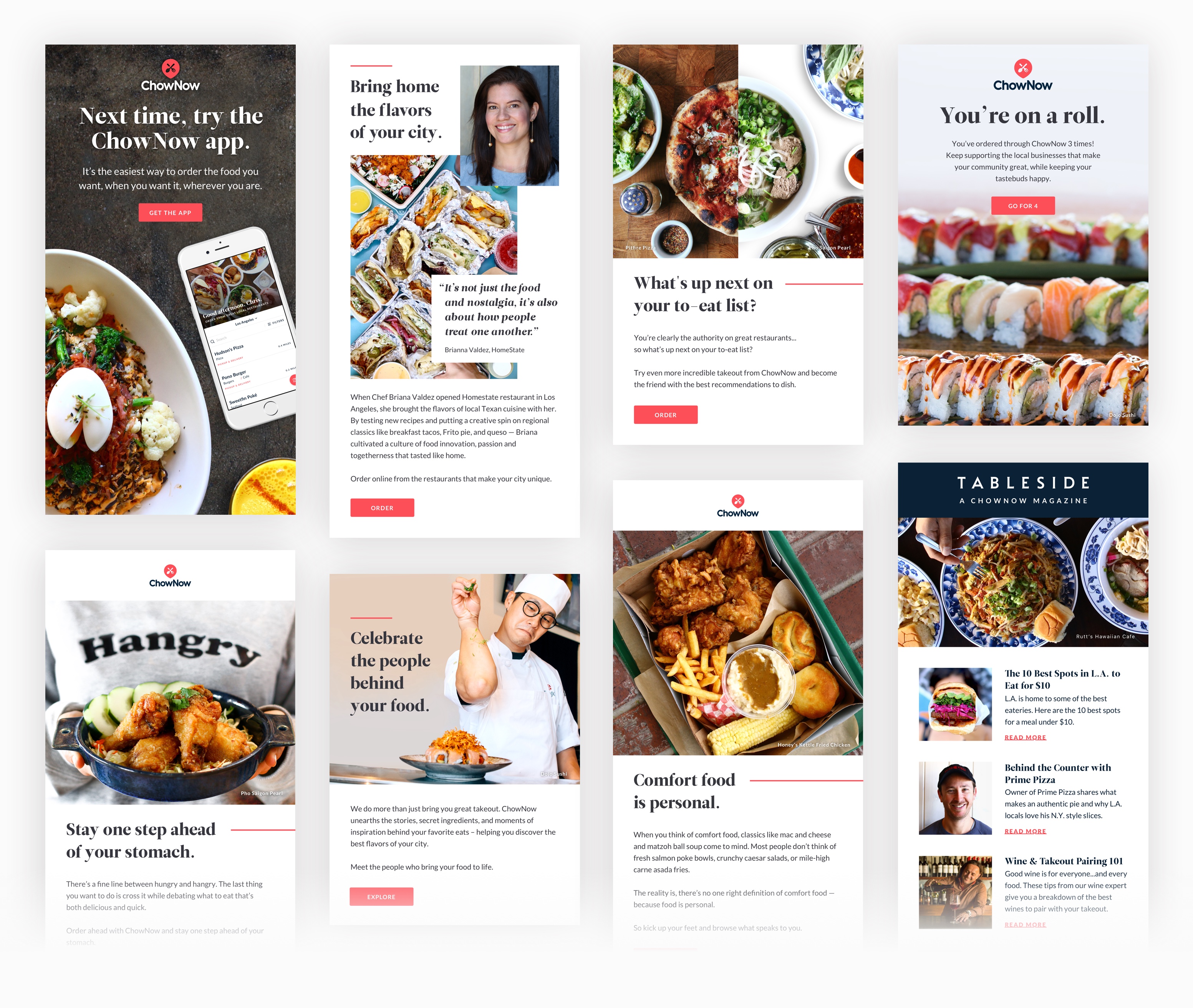
Learnings
Going through a rebrand is always an exciting journey. There were a lot of things that were done right from the beginning such as conducting a thorough competitive landscape, taking inventory of current branded assets/materials that needed to be redesigned, and creating a design system and branded style guide where all the information lives. While we had a few formal presentations to the company to gain interest and buy in for the rebrand, one missed opportunity was offering visibility into the creative process that the design team and stakeholders went through. The entire rebranding process took over a year in which priorities were shifted and larger initiatives had to be put on hold. Offering visibility such as research findings, the nuances of designing for countless types of assets, and even versions that did not end up working would mitigate the waiting game, reinforce the creative process, and gain buy-in for design. Documentation is also an essential piece of the design process that allows the design organization to move forward in improving the brand.
LEARNINGS
Going through a rebrand is always an exciting journey. There were a lot of things that were done right from the beginning such as conducting a thorough competitive landscape, taking inventory of current branded assets/materials that needed to be redesigned, and creating a design system and branded style guide where all the information lives. While we had a few formal presentations to the company to gain interest and buy in for the rebrand, one missed opportunity was offering visibility into the creative process that the design team and stakeholders went through. The entire rebranding process took over a year in which priorities were shifted and larger initiatives had to be put on hold. Offering visibility such as research findings, the nuances of designing for countless types of assets, and even versions that did not end up working would mitigate the waiting game, reinforce the creative process, and gain buy-in for design. Documentation is also an essential piece of the design process that allows the design organization to move forward in improving the brand.
LEARNINGS
Going through a rebrand is always an exciting journey. There were a lot of things that were done right from the beginning such as conducting a thorough competitive landscape, taking inventory of current branded assets/materials that needed to be redesigned, and creating a design system and branded style guide where all the information lives. While we had a few formal presentations to the company to gain interest and buy in for the rebrand, one missed opportunity was offering visibility into the creative process that the design team and stakeholders went through. The entire rebranding process took over a year in which priorities were shifted and larger initiatives had to be put on hold. Offering visibility such as research findings, the nuances of designing for countless types of assets, and even versions that did not end up working would mitigate the waiting game, reinforce the creative process, and gain buy-in for design. Documentation is also an essential piece of the design process that allows the design organization to move forward in improving the brand.
LEARNINGS
Going through a rebrand is always an exciting journey. There were a lot of things that were done right from the beginning such as conducting a thorough competitive landscape, taking inventory of current branded assets/materials that needed to be redesigned, and creating a design system and branded style guide where all the information lives. While we had a few formal presentations to the company to gain interest and buy in for the rebrand, one missed opportunity was offering visibility into the creative process that the design team and stakeholders went through. The entire rebranding process took over a year in which priorities were shifted and larger initiatives had to be put on hold. Offering visibility such as research findings, the nuances of designing for countless types of assets, and even versions that did not end up working would mitigate the waiting game, reinforce the creative process, and gain buy-in for design. Documentation is also an essential piece of the design process that allows the design organization to move forward in improving the brand.
LEARNINGS
Going through a rebrand is always an exciting journey. There were a lot of things that were done right from the beginning such as conducting a thorough competitive landscape, taking inventory of current branded assets/materials that needed to be redesigned, and creating a design system and branded style guide where all the information lives. While we had a few formal presentations to the company to gain interest and buy in for the rebrand, one missed opportunity was offering visibility into the creative process that the design team and stakeholders went through. The entire rebranding process took over a year in which priorities were shifted and larger initiatives had to be put on hold. Offering visibility such as research findings, the nuances of designing for countless types of assets, and even versions that did not end up working would mitigate the waiting game, reinforce the creative process, and gain buy-in for design. Documentation is also an essential piece of the design process that allows the design organization to move forward in improving the brand.
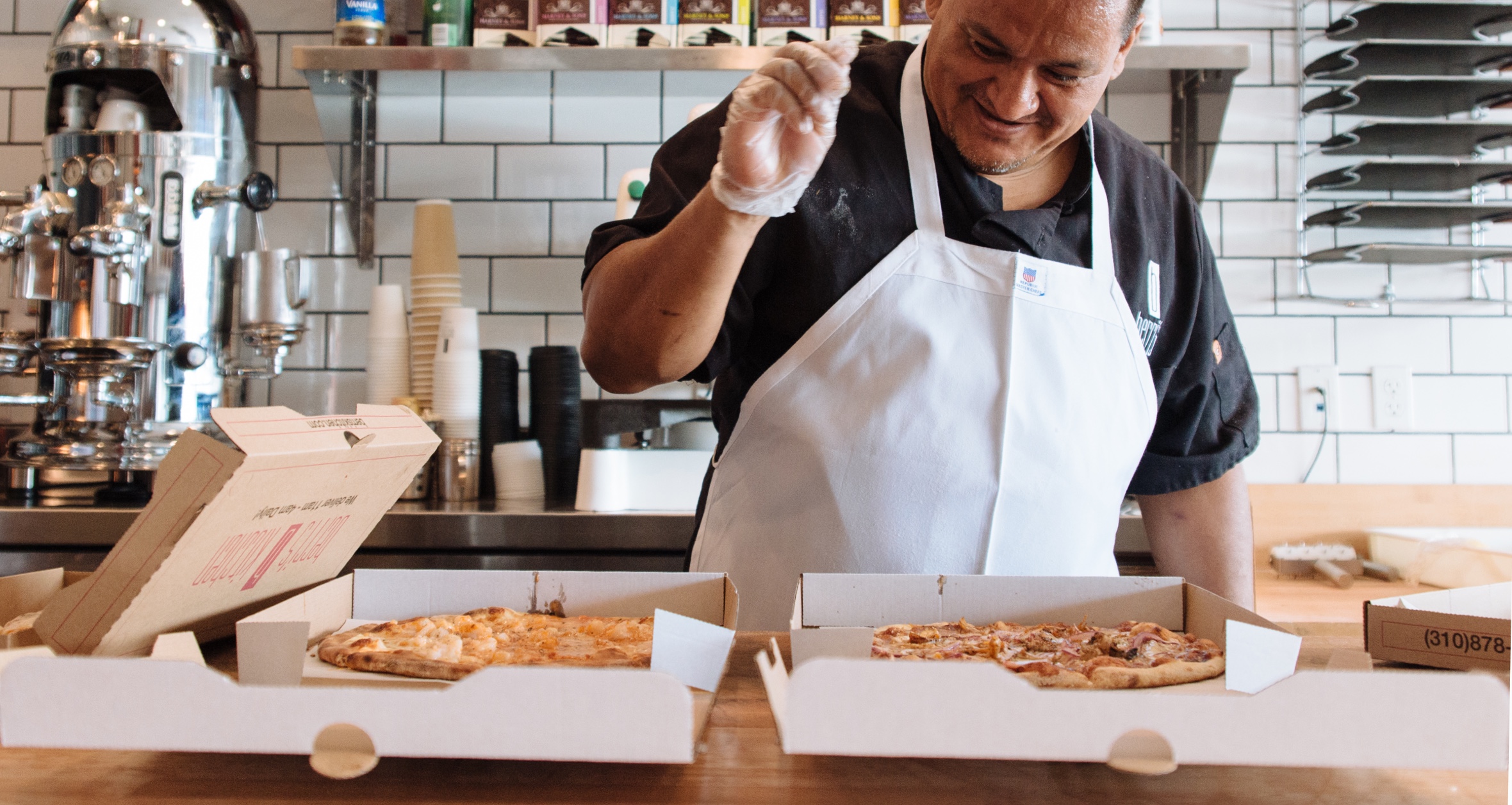
THE TEAM
Ashley Romo, Product Designer
Fabian Segura, Sr. Communications Designer
Cheryl Abumoussa, Communications Designer
Nicki Pena, Restaurant Marketing Design Lead
Agency resources through Assembly Co
The Team
Ashley Romo, Product Designer
Fabian Segura, Sr. Communications Designer
Cheryl Abumoussa, Communications Designer
Nicki Pena, Restaurant Marketing Design Lead
Agency resources through Assembly Co
The Team
Ashley Romo, Product Designer
Fabian Segura, Sr. Communications Designer
Cheryl Abumoussa, Communications Designer
Nicki Pena, Restaurant Marketing Design Lead
Agency resources through Assembly Co
THE TEAM
Ashley Romo, Product Designer
Fabian Segura, Sr. Communications Designer
Cheryl Abumoussa, Communications Designer
Nicki Pena, Restaurant Marketing Design Lead
Agency resources through Assembly Co
THE TEAM
Ashley Romo, Product Designer
Fabian Segura, Sr. Comms Designer
Cheryl Abumoussa, Comms Designer
Nicki Pena, Design Lead
Agency resources: Assembly Co
Next Project
Next Project
Next Project
MakeSpace
MakeSpace
MakeSpace
MakeSpace
MakeSpace
